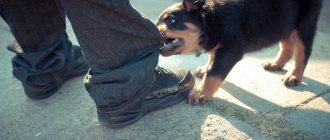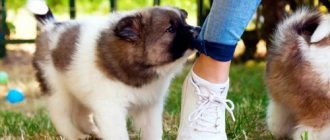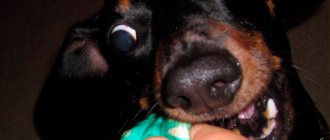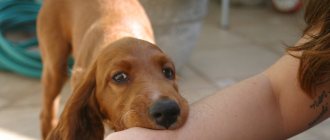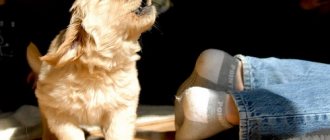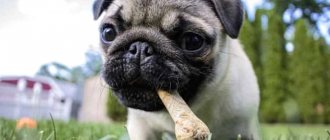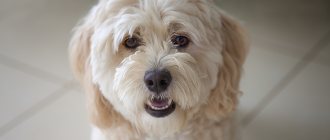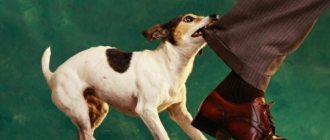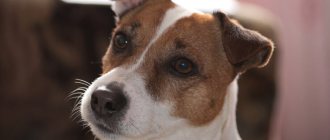I hear this question quite often, more often than I would like. But this is the reality - among dogs of any breed, some more often (service, hunting), others less often (decorative) there are individuals with a hereditary predisposition to aggression
.
In this article I want to show the general picture of this phenomenon and give recommendations to owners who are “lucky” to acquire such a dog.
And the first thing I want to say is, since you acquired a dog with such heredity, you cannot be blamed for this.
The problem of hidden evidence.
The author of this term, mathematician, philosopher and successful trader, Nassim Nicholas Taleb.
In his magnificent book “The Black Swan”, he, citing Cicero, gives the following story.
“The Greek philosopher Diagoras, nicknamed the Atheist, was shown images of people who prayed to the gods and were saved from a shipwreck. It was understood that prayer saves from death. Diagoras asked: “Where are the images of those who prayed, but still drowned?” It is not so easy for pious drowned men to express their opinions from the bottom of the sea for the reason that they are dead.”
Next, he cites the opinion of Michel de Montaigne and Francis Bacon, who saw in this story an example of the origin of all superstitions. In particular, Bacon wrote: “This is the basis of almost all superstitions - in astrology, in dreams, in superstitions, in predictions and the like.”
The book is wonderful and I recommend reading it to everyone who wants to understand the nature and role of chance in our lives.
I hope that you understand that by quoting these excerpts from Nassim Taleb’s book “Black Swan”, I want to say that belief in “dogs that unconditionally love people” is akin to the superstition of our days. And that by starting a conversation about aggressive dogs, we touch on the problem of hidden evidence - we do not know how many dogs actually attack people, because their owners prefer to remain silent, feeling condemned by society.
If dogs with hereditary aggression regularly appear, and the owner is not really to blame for this, then who is to blame for this? Let's figure it out.
Dangerous games with sticks
Is it possible for dogs to chew sticks? Should you fearlessly allow your beloved pets to play with them? In short, sticks are not safe toys for animals, let's look at why:
- When letting your dog play with a stick outside, you can never be sure that there are no pathogenic bacteria or viruses on its surface
. There is a possibility that the stick picked up from the ground was recently chewed by an infected animal. What if we are talking about a stick that the owner plucks from a tree just before giving it to his dog? Well, this is also not the best toy, since it may also have dangerous germs left by birds or insects; - A stick picked up from the ground may contain eggs of endoparasites - helminths
. They will happily penetrate the dog’s body, significantly worsening the animal’s quality of life; - It is dangerous for puppies to chew sticks during the teething period, when their gums ache very much
. Any stick (even one plucked from a tree growing in your own garden) is not free from contamination, which can cause severe inflammation of already suffering gums; - According to [1] veterinarian Jason Nicholas, sticks often cause dogs to suffer lip lacerations, tongue punctures, and palate punctures
. During play, the wood gets stuck in the gums and leaves scratches on the tooth enamel (loss of a tooth while chewing wood is also possible). It is also worth noting that animals can injure their sensitive nose when playing with a stick; - It also happens that a dog eats sticks, and does not just chew them. This can lead to injuries to the pharynx, larynx and trachea
[1].
In addition, ingesting large amounts of wood can cause blockage in the stomach and intestines
[1]. If a dog chews sticks too often, he may experience constipation, nausea, and other unpleasant problems; - A sharp stick during gambling can pierce a dog's chest, possibly causing injury to the diaphragm, lungs, or heart
[1]. And if a stick penetrates the stomach, damage to the liver, stomach, spleen, gall bladder, intestines, and bladder is possible. That is, a seemingly harmless game can cost an animal its life; - Eye injuries and damage to the nerves and blood vessels of the organs of vision
cannot be ruled out when a dog plays with a stick.
In addition, a sharp and long stick, hitting the eye, can even penetrate the animal’s brain
[1], which is fraught with too serious consequences; - The owner is not always exactly sure which tree his pet is chewing on. The fact is that the bark of some trees and shrubs is extremely poisonous to dogs
[2]. So, for example, contact with the wood of yew trees [2] can lead to disastrous results in the form of convulsions, severe vomiting and bradycardia, even death is possible; - Some dogs that love to chew picked up sticks while walking continue their “fun” game at home
, biting the wooden legs of tables and chairs. Such amusements give the home an unattractive appearance, and the owner has to spend money on repairing damaged furniture or buying new furniture.
Well, it turns out that sticks are not so harmless. And in some cases, they can even cause death, depriving the animal of the most precious thing - life.
Breeders' fault.
I believe that the breeders who supply a new generation of puppies to the market every six months are primarily to blame.
Of course, among them there are real professionals who take their work or hobby seriously and responsibly. Seriously, this means that they monitor all cases of the appearance of puppies with such heredity and, at a minimum, do not sell them to inexperienced people, but experienced people are warned about the level of dominance of the puppy, and, at maximum, such puppies are euthanized. This is the other (dark) side of this profession.
Unfortunately, most breeders breed their bitches with only one goal in mind – making a profit. Their task is to get as many offspring as possible from a female of the currently popular breed. She gave birth to seven puppies - all seven will be sold, she gave birth to twelve puppies - great, the profit will be even greater. After all, you need to “seize” the moment! Soon there will be many dogs of this breed and it will cease to be fashionable.
Therefore, a lot of dogs of two extreme, obviously problematic psychophysiological types appear on the market every year - dominant
and
cowardly
(non-dominant).
For what reasons does a dog become dominant?
Some dog breeders claim that their pets suddenly changed their behavior out of the blue. But you need to understand that a dog cannot growl at its owner without a reason. Most likely, this is a consequence of gaps in upbringing.
Excessive love, lack of training regimen and all kinds of indulgence in the pet leads to dominant behavior of the animal. Every dog looks closely at its owner for the first time. He evaluates your reaction to his behavior, tries to grasp the line of permissiveness and understand how much you can be controlled.
If you miss this “evaluation” period, hoping that the dog will grow up and learn everything on its own, the pet will soon become the leader of the pack (family). At the slightest disapproval of his actions, punishment will follow - a growl or an attack on the owner.
A clear illustration of dominance:
- The animal dares to sleep in your bed. When the owner tries to take his place, he bares his teeth and growls angrily. After all, a leader has the right to choose the best place for himself.
- The dog can show both insatiable curiosity and open aggression towards guests coming into the house. At the same time, the owner is unable to pacify him or take him to another room.
- A well-mannered dog should wait for family members to dine, and only then count on its own portion. The “leader” rushes first to the table and demands tidbits. He takes the food into the room and snaps when you try to stop him.
- Ignoring commands by an adult dog that previously followed them. This is not a small puppy who could get carried away by playing and not hear the order. Insubordination is a clear demonstration of a dominant position. By its behavior, your pet indicates your poor leadership qualities. Irritation and empty screaming will only strengthen righteousness in the animal’s mind.
- During a walk, the dominant dog will run ahead of the owner and pull hard on the leash. Walking alongside means recognizing you as a leader.
- During the game, the animal sets the rules. If you try to do it your way, the pet will burst into barking or growling in displeasure.
Dogs are often respectful of adults, but children are treated as equals or at a lower level. They behave unrestrainedly with children, are irritable, bare their teeth and bite. This is especially true when parents yell at them in the presence of an animal.
The fault of journalists
Since the cash flow in this business is very large, this leads to the next problem - no one wants to hear about dog aggression again! This will reduce their attractiveness to a new wave of buyers.
Everyone is vying with each other about how dogs of each breed “love children,” “protect family members from criminals,” “smart” and “genius,” and so on and so forth.
The lobby is so strong because all these “votes” are paid for by a significant amount of banknotes.
Therefore, the topic of dog aggression is not popular among journalists, who produce all these “fables” about “honesty” and “decency,” the “universal love” of dogs for us and other, other nonsense!
Treatment to protect resources in puppies
If your puppy is growling at you to prevent you from taking something valuable to him, you should work positively on this behavioral problem as soon as possible, as this long-term problem has very negative consequences and, if not addressed, it can easily get worse .
To redirect this behavior, it is important that your puppy does not see you as a threat who wants to “steal” something, but he will have to associate your presence with something positive. For example, if your puppy growls and bites you when you approach his food bowl, stand at a distance where he feels calm and then reward him with a very juicy treat (more than his usual food) for being calm. Gradually move closer and help him associate your presence with a reliable and protective figure, so that he no longer feels that you are a threat when you approach his food, but rather the opposite.
For greater safety, you should gradually do the same procedure with other family members. Well, even if he no longer feels insecure around you, he may continue to growl at other people or animals. Always, and very importantly, maintain a safe distance where your pup is safe and avoid at all costs punishments that will only cause more distrust of your furry pet.
If you think this problem has become unmanageable because it has been going on for too long, it is best to contact a professional as soon as possible so they can give you personalized advice.
Author of the article: Jungle Luque. Ethologist and Trainer I am an ethologist specializing in dogs and cats, a dog trainer and a psychology student. I have been fortunate to deal with a wide variety of animals throughout my life, be it farm animals, small mammals or birds. That's why I love learning from them, and perhaps in the future I would like to continue my studies by studying horse behavior in more depth. Finally, I want to be able to express my appreciation for the animal kingdom, as well as help those who are interested in understanding and improving the well-being of their pets.
The fault of dog breeders (ordinary dog owners).
Fortunately for everyone, despite the chaos in dog breeding, most puppies are born with an optimal psychotype and therefore do not show aggression towards owners and strangers, even if the latter treat them inhumanely, without training them, but punishing them for any “offence” ( By the way, these methods of “education” are common for any despotic state and are not condemned by society).
The owners of these dogs are firmly convinced that the lack of aggression in their pets is solely their merit. They are “brilliant educators”, “brilliant trainers”, “brilliant zoopsychologists”! And, therefore, choking on their own uniqueness, they also sing along with the journalists in every possible way - “Only from a dog’s life, a dog can bite!”
Tips for puppies with fear
If your puppy is new to your family and has a rather fearful personality, if he has not had human contact since childhood, or if he has had negative experiences such as abuse, it is understandable that he will express fear or mistrust if you approach him , caress him, take him in your arms...
Given the circumstances, you need to be patient and give him time to adjust to his new environment and family. This means that you should avoid situations in which he might feel uncomfortable (such as walking straight towards him if he leaves, or directly picking him up) and encourage him to be the one who approaches you through encouragement, sweet words and avoiding sudden movements. This way, you will gradually make him associate you with a positive and reliable person.
The fault of dog trainers.
Since truly competent specialists - trainers in our country can be counted on the fingers of one hand, and the mass of instructors in domestic sports dog training courses - OKD (general training course) and ZKS (protective guard service, read - service in a concentration camp) significantly exceeds the critical one, then the effectiveness of their work at training sites (despite state support) is extremely low.
And since the country does not train specialists in the correction of problem behavior in dogs, they are trying to be replaced by the above-mentioned instructors who offer owners of aggressive dogs, for a decent fee, to correct this problem in one or two months (?).
And of course they correct it, I have no doubt about this, because at one time I carefully read the literature on torture at the Lubyanka, when even “faithful Leninists” admitted to all possible crimes against the party and the people. Agree that such specialists will “fix” not only your aggressive dog in two months!
Why might a dog growl at its owner?
A dog's growl is a sign of dissatisfaction. There may be several reasons for concern that provoke a dog’s aggression towards its owner:
- Personality formation. This usually happens in adolescence, when the male tries to assert himself and take a leading position. Suddenly, a demon breaks out of a meek, friendly dog, and he turns into an evil creature. Instincts are to blame for everything - the animal strives to become a leader. Tries to take over new territory, for example, the owner’s bed. It can growl and bark at guests, defending its possessions. By demonstrating fearlessness, the male confirms his importance.
- A response to cruelty. Aggression and violence on the part of the dog owner towards the pet provokes counter-anger. Shouting or beating cannot achieve obedience. This dog growls when you pet it. She is not used to affection, so she is always anxious in anticipation of impending danger. This means that trust in the owner has been lost, and the animal is in a state of constant stress.
- Defensive reaction. You may not realize how threatening your raised voice sounds. Excessively active gestures and behavior of the owner that is unusual for the dog may seem suspicious. For example, returning home in a state of alcoholic intoxication, an unfamiliar smell emanates from you, you behave strangely, your voice sounds different. The dog may have doubts: has his owner been replaced?
- Unconditional leader. The tendency to dominate is inherent in many breeds. It manifests itself in communication with surrounding people and other pets. By pampering and indulging his pet in every possible way, the owner makes a fatal mistake. The dog begins to jealously protect its belongings even from its owner. Seeks to take possession of objects that do not belong to her. With an animal grin she asserts her rights.
- Competitive fight. If there are other pets in the house, the dog will strive to take dominance. Skirmishes between animals are inevitable in the struggle for territory and the attention of the owner. If the owner takes the side of one of them, the second will harbor a grudge and become embittered.
- Aggression while eating. A common occurrence among ill-mannered pets. Distracted from food, the dog growls when the owner is nearby. If you try to take a bowl or bone from her, she may bite. Such pets are not trained to correctly take “sweets” from their hands and grab their fingers with their teeth.
- Losing control of the game. It would seem that a harmless growl or bark during play should not cause the puppy to become angry. But if the baby understands that this is normal, then over time he will begin to bite the owner. When an adult dog behaves this way, it becomes very sad.
- Hunting skills. There are similarities with game dogs, but they are based on the instinct of hunting dogs to track and drive prey. In urban conditions, a cat or other animal may become a victim. It is not normal if the owner tries to stop the pet and receives a grin in response. For centuries, hunting breeds have been ingrained in their kindness towards people.
- Excessive attention. Any living creature requires rest and tranquility. A dog may growl at a person if it is tired and irritated. So, if a child is chasing her all the time, she begins to snap at the level of instincts. Constant stress provokes the animal to growl.
- Unconscious aggression. The reaction often occurs in pets of guard breeds. If the dog is in deep sleep, he is not aware of what is happening. A sudden awakening from the noise forces him to defend himself. At the same time, he still does not understand who is standing in front of him and can even rush at the owner.
- Maternal instinct. A female puppy selflessly protects her offspring, sometimes even from the owner himself. This is a completely natural reaction, but it is strictly not recommended to encourage such behavior.
- Pain and malaise. The reasons for a dog's suffering when sick are not always visible. Experiencing pain and discomfort, the animal tries to hide in a secluded place to rest. If she is disturbed in this, she may bare her teeth and growl.
Owners of aggressive dogs are lonely and defenseless!
Now I hope you, the owners of aggressive pets, understand that you are powerless against this mass of amateurs, deceivers and “true believers”!
If you declare your problems on dog forums on the Internet, then this entire “pack” will attack you like you have the plague. To begin with, she will blame you for what happened, then these “dog trainers” will offer you thousands of absolutely useless “methods of correcting” the dog, and when you offer them to take your dog for “training,” of course, they will tactfully remain silent.
Why not scold your puppy if he growls?
As we already mentioned, growling is a sound that indicates that something is bothering your puppy or that he is not feeling well. This sign is usually a warning telling us to stop doing things that make the puppy feel bad. But what happens if you scold your dog when he growls? Although you may be bothered by your dog's growling, you should not perceive it as a threat, but as a necessary form of communication that the animal uses to ask you to stop.
When you scold your dog, you may suppress the growling, which means the dog stops communicating, but this does not mean that you will solve the main problem: what makes your dog feel bad. So, unfortunately, by doing this you will ensure that when your dog is upset, he will not tell you about it, and if there comes a time when he feels really upset about the situation, he will immediately bite you to ask you to stop without advance warning of its status. To give an example of how we might understand this from a human perspective, it would be the equivalent of instead of dealing with an unpleasant situation by asking “please stop,” we would directly resort to physical aggression since verbal communication would be futile. because the other person is not listening to you.
© shutterstock
Finally, using violence in training your furry pet is completely counterproductive to building a trusting relationship with your puppy because, as you have seen, the reasons why your puppy growls and bites is due to fear or uncertainty that certain situations create. Obviously you can't try to resolve this behavior in a more dangerous way.
What should the owner of an aggressive dog do?
What can I, a specialist in the correction of aggressive behavior in dogs, advise you? I'll try to look at the problem from different angles.
First, some practical tips.
- Do not take your dog to a training area - training courses there are designed to cull dogs like yours.
- Do not submit it for training to a specialist who offers you to correct the dog’s aggression in one or two months. During this period, you can only beat the dog to death (and the super-dominant dog will prefer death to slavery and violence). Professional dog training lasts at least six months, because only during this time, if we do not hit, but train the dog, it develops persistent behavioral stereotypes - habits! Ask such a specialist to show his “portfolio” - give the addresses of dog owners whose aggression has been corrected by this specialist, and talk to them. This way you will solve the problem of “hidden evidence”.
Now I will share with you general considerations, after which, I hope, you will take decisive steps and you will not be tormented by remorse.
- Since, in the overwhelming majority of cases, you bought a dog with such heredity, then no matter how you treated it (petted, fed the best pieces from your table, kissed and hugged, slept in the same bed, walked until you dropped, trained according to the OKD course a lot years in a row or punished), your dog will bite and the danger will increase as it grows up and gains “combat experience”.
- If a puppy or a young dog (up to one and a half years old) shows aggression, and you are a disciplined, persistent, motivated and fairly athletic owner (male or female, it doesn’t matter), then you will cope with the problem on your own by completing our leadership and role-playing dog training course ( LIROS) without outside help.
- If you have an adult dog (two years or more) and you do not have any of the above advantages, then you will not be able to cope with the problem without the help of a professional.
- Even after training, living with a dominant (aggressive) dog requires strict adherence to the rules of “feeding”, “cleaning the territory”, “walking”, “communication and training” formed by training, that is, compliance with a certain “Charter”. For emotionally stable and disciplined people this does not pose a problem, while for people with an unbalanced psyche and unresolved personal problems, a dominant dog will be dangerous both for the owner and for the people around him.
- If you are an average dog lover, that is, you did not purchase it for “military operations” and to live with it according to the “Charter of Garrison and Guard Service”. Then consider that you were simply unlucky and you did not buy “your dog”! Therefore, break up with her as soon as possible.
- When buying a puppy, invite a specialist to test its level of dominance, which can be determined in puppies at one month of age (working in Moscow, I often did this at the request of clients).
- Having purchased a puppy, do not play “Russian roulette”, immediately start training your pet according to the only course that aims to achieve harmony in the relationship with the dog - leadership and role training for dogs (LIROS) .
- If you prefer risk (you decide to raise a dog without training) and it begins to attack you or members of your family, then honestly admit to yourself - do you need such a dog?
- If you have small children in your family, get rid of the dog immediately, because its life is worth nothing next to the tears and pain of our children!
- Do not shift the problem onto the shoulders of other people by placing an aggressive dog in “good hands.”
How to stop a dog from chewing sticks
It is quite obvious that a stick, although simple and completely free, is far from the best toy for an animal. How to stop a dog's interest in sticks? You can try the following steps:
- To switch the dog’s attention from sticks to something else, it is worth purchasing a variety of toys
in the form of balls, squeakers, rattles, plates (or others). It is important that they are made of high-quality materials and do not have parts that a pet can easily bite off. Let toys be available to the animal at any time; - When going for a walk, you should take with you some kind of dog toy and treat
. As soon as the animal shows interest in the treasured stick, he should immediately be offered a toy. If the dog takes the toy, forgetting about the stick, it will have to be praised and treated. By the way, it’s great if the animal knows the commands “Fu!” and “You can’t!”, and besides, he obeys his owner. It will be much easier to “agree” with a trained animal; - During a walk, it is worth switching the dog’s attention from the sticks lying on the ground to something more interesting. You can offer the dog some interesting game
, for example, catching up or catching a rubber ball. The owner is required to set a good tone for the game, that is, he needs to be on the same cheerful wavelength with his pet; - A dog that loves sticks can be outwitted
. To do this, you need to take several fairly thick sticks without sharp edges (it is better if they are torn from a tree rather than picked up from the ground). The wood of these several sticks needs to be smeared with something bitter, for example mustard. If you do this trick for several days, the dog will most likely refuse to chew the sticks in the future, believing that for some unknown reason they have all become very tasteless. In addition to mustard, you can use special sprays that help stop animals from chewing on everything. Such products are sold in pet stores; - Some dogs don't chew sticks for fun. Their body simply requires plant foods containing vitamins, minerals and fiber. Perhaps the owner should reconsider his animal's diet
by including vegetables and even some fruits. If you don’t want to adjust the menu, you can consult a veterinarian about taking vitamin supplements; - Some dogs may be affected by this trick. When going for a walk, you need to take with you a small spray bottle filled with clean water
. If the animal grabs sticks from the ground without responding to the commands “Fu” and “No”, a small amount of water will have to be splashed on the nose of the naughty animal. Most likely, after such a “shower” the pet will release the stick from its mouth. Of course, you can spray water on the face only in the warm season; - In the center of a large metropolis there are not so many sticks lying on the asphalt. But during a foray into nature, finding them is easier than ever. The owner of the animal can take with him a whistle
, which he will have to whistle every time the animal grabs a stick. The dog will most likely release the stick from its mouth when distracted by the loud noise.
Conclusions:
If you do not have the time and money to train your dog and you have made the difficult but wise decision to euthanize (humanely euthanize) an aggressive pet, act decisively - invite a veterinarian home. An intelligent and competent veterinarian will never judge you for this!
And one more comforting argument. Know that in any civilized country, if a dog attacks a person, the laws require the immediate euthanization of the animal. They won’t even ask you for your consent!
Therefore, I repeat once again, if your dog shows aggression towards people (primarily family members), then in the overwhelming majority of cases, it is not your fault!
Be courageous in your decision, I will always be on your side!
You can get detailed information about the new method of leadership-role training for dogs by purchasing my book .
And so that there would be more joy and less grief in our dog world, we decided to open the Ploskov Dog Training School. An announcement about the recruitment of students will be published on the website in the near future.
Share on social media networks
RќСЂР°РІРёС‚СЃСЏ
Ways to correct aggression in dogs
In order to get rid of negative behavior on the part of an animal, first of all, it is necessary to remove all the signs and irritants that provoke the pet.
By following long-proven principles and solutions, you can train your dog well, eliminate aggression and correctly correct its behavior. To do this you need:
- Get rid of all sorts of reasons and factors that can provoke unsatisfactory things;
- Your friend's behavior;
- Under no circumstances use force or punishment for any offense against an animal;
- Let your pet know who is the leader and leader in the house from the first days of your life together;
- Develop good habits in your dog through a good attitude, attention, affection and rewards for completed tasks.
Before going through OKD with your four-legged friend, find out more information about the dog handler who will work with your dog, his professionalism, and experience. This is very important, since the wrong approach to training can harm the animal even more. Many experts recommend taking courses several times over a certain period of time.
Medication method
Very often, along with training, they undergo a course of drug therapy. It involves suppressing aggression with the help of sedatives, which must be prescribed by a veterinarian after a thorough examination of the animal. Dog handlers speak only positively about such drugs and consider them useful.
A course of anxiolytic therapy helps reduce your pet's excessive anxiety, which contributes to an aggressive attitude. This increases the effectiveness of the correction course.
An important role in a dog’s behavior is played by its character, and not by its level of reactivity. Thus, to achieve a high-quality result, training alone is not enough. Therefore, experienced veterinarians strongly recommend using special medications that suppress pet aggression by blocking impulses in the brain. This helps to significantly improve the entire course and achieve excellent results.
However, you should not think that medications and OCD will do all the work for you. Most of the result depends on the good and attentive attitude of the owner towards his pet. By caring for your dog, you are also taking care of yourself and your loved ones.
Currently reading:
- Games to choose for training a dog
- Recommendations for obedience of a dog if it growls
- The American Cocker Spaniel is an adroit hunter and loyal friend.
- Actions to take in case of an epileptic attack and a shaking dog

